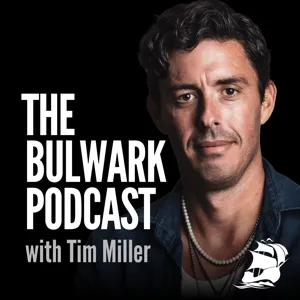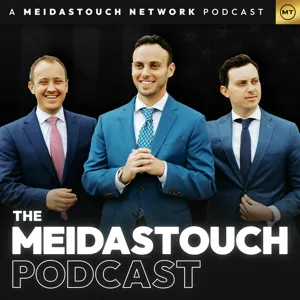Podcast Summary
The Republican Party's transformation into a chaotic and fractured movement: Since 2010, the GOP has shifted from a disciplined and ideological party to one that obstructs, sabotages, and disrupts, regardless of whether they're in power or not, leading to internal conflict and lack of control.
The Republican Party, which was once seen as a disciplined and ideological political force, has transformed into a chaotic and fractured movement. This shift began around 2010 with the rise of the Tea Party and has continued to the present day. Unlike Democrats, who tend to fall in line and nominate the next in line for leadership positions, Republicans have a tendency to obstruct, sabotage, and throw sand in the gears, whether they are in the majority or the minority. This internal conflict and lack of control is not normal for political parties and raises questions about who profits from this version of the Republican Party and who perpetuates it. Historian Nicole Hemmer, who studies the Republican Party through the lens of its media, provides valuable insights into this topic.
Newt Gingrich's Rise to Power in the 1990s: Historian Newt Gingrich's innovative ideas and the political climate of the 1990s combined to remake the GOP, with his leadership on ethics charges and budget deals cementing his influence.
Newt Gingrich's rise to power in the Republican Party in the 1990s was a result of both his innovative ideas and the political climate of the time. Gingrich, a historian and former professor, had long aspired to remake the GOP and built institutions within the party to do so. He gained momentum through political victories against both Democrats and his own party, including leading ethics charges against a powerful Democrat and opposing President Bush on a budget deal. However, it's debatable if Gingrich was the only figure who could have led the counter-establishment, culture war-like movement in the Republican Party at that time, as other figures like Pat Buchanan and Rush Limbaugh also rose to prominence during this era. Ultimately, Gingrich's innovations and the political climate came together to put the Republican Party on a new path.
1992 Election: Conservative Figures Challenge the Status Quo: The 1992 election marked a turning point for the Republican Party, with conservative media figures like Pat Buchanan, Rush Limbaugh, and Newt Gingrich gaining influence, and candidates increasingly relying on their support
The 1992 election marked a pivotal moment in the Republican Party as conservative figures like Pat Buchanan, Rush Limbaugh, and Newt Gingrich challenged the status quo. Buchanan represented a more populist, protectionist wing of the party, while Limbaugh used his media influence to rally the base. Gingrich, a savvy political figure, sought to attract disillusioned voters from third-party challenger Ross Perot. The Bush administration recognized the power of conservative media and attempted to court Rush Limbaugh, leading to a defining moment where Bush carried Limbaugh's bags. This dynamic foreshadowed the growing reliance of candidates and presidents on conservative media systems. The failed 2007 immigration reform effort, where Bush and the business wing of the party faced a massive revolt, further illustrates this trend.
Conservative Media's Influence on Republican Party and Political Landscape: Conservative media, especially talk radio, has shaped the GOP and political landscape, with a long history of activism and criticism of mainstream media, and a level of institutional integration and political identity building that the left has yet to replicate.
Conservative media, particularly talk radio, has played a significant role in shaping the Republican Party and political landscape, often outmaneuvering the Republican establishment. This power stems from a long history of conservative activists using media as a tool for ideological change, with a robust criticism of mainstream media as biased towards liberalism. Conservative media institutions not only spread messages but also engage in politics on an institutional level, with a 70-year history of building institutions and political identity. The left has yet to replicate this level of media and political integration on the same scale. The media landscape also features a liberal bias in major newsrooms, with liberal media outlets integrated into larger mainstream media organizations, resulting in a self-imposed restraint that conservative media lacks.
Different business incentives for conservative and liberal media: Conservative media prioritize politics and devotion, while liberal media aim for broad appeal and professionalism.
Conservative media and liberal media have different business incentives due to their unique approaches to reaching and retaining audiences. While mainstream media strive for broad appeal and adhere to professional practices like objectivity, conservative media identified the value of a devoted audience early on and built their success around it. Conservative media figures like Rush Limbaugh understood the power of micro-targeting and entertaining their audience with political messages, emotions, and humor, which helped them build profitable institutions and significant political influence. Unlike mainstream media where politics might not be the primary reason for viewership or readership, conservative media thrive on their political messaging. This difference in business models and audience priorities has led to distinct ideologies and outcomes in media and politics.
Identity and mission shape conservative media's content and audience: Conservative media outlets cater to political conservatives, focusing on stories and narratives with a political slant while trying to mediate between different wings of the Republican Party, but ultimately influenced by the more ethno-nationalist counter-establishment base.
The identity and mission of conservative media outlets shape their content and the audiences they attract. These outlets often position themselves to represent and appeal to a political conservative niche, which can lead to a focus on stories and narratives with a political slant. However, they also aim to mediate between different wings of the Republican Party, but ultimately, they need their audience and are influenced by the more ethno-nationalist counter-establishment base, which is increasingly becoming the dominant force within the party and conservative media. The New York Times, for instance, has a diverse range of content, but cooking and recipes are still important to its business. Similarly, the Wall Street Journal and NPR have broader missions beyond politics, which sets them apart from conservative media outlets.
The relationship between right-wing media and the conservative base is complex: Right-wing media shapes views but also needs audience engagement, seen in immigration and election backlashes. The rise of alternative media options empowers the base to express dissatisfaction.
The relationship between right-wing media and the conservative base is more complex than a one-way influence. While media outlets like Fox News have some influence on shaping viewers' perspectives, they also need their audience, who are often voters, to stay engaged. The 2013 immigration issue and the 2020 election backlash are examples of this dynamic. The rise of a robust right-wing media ecosystem, including options like Newsmax and One America News, has empowered the base to express their displeasure and switch channels. The Republican Party's contradiction between its corporate and urban, cosmopolitan wing and the ethno-nationalist wing has been present for decades, but the growing power of right-wing media and its attachment to social media has made it more responsive to the base's concerns.
Tension between conservative and moderate bases in the Republican Party: The Republican Party's internal conflicts stem from the growing strength of its conservative base, which has weakened the party as an institution through independent fundraising and messaging, making it difficult to discipline members and maintain cohesive policy agendas.
The Republican Party has become a coalition of contrasting bases, with the conservative base growing stronger through media, organization, and small donor fundraising, while the moderate wing has weakened. This tension between the two bases has led to constant conflict and a lack of cohesive policy agendas. The base's ability to fundraise and spread their message independently weakens the party as an institution, making it difficult for it to discipline members like Marjorie Taylor Greene. The party's ideological cohesion, while true, does not prevent these internal conflicts, which have been particularly evident in primaries since 2010. The Republican Party's structure has shifted, with the base's access to new tools and resources allowing them to challenge and even replace more established figures. This dynamic continues to shape the party's direction and agenda.
DeLay's Leadership and Party Unity: Tom DeLay's leadership in the Republican Party was marked by greater party discipline and unity due to new rules, conservative media, and the unifying effect of 9/11 and the War on Terror.
The period of Tom DeLay's leadership in the Republican Party, following Newt Gingrich, was marked by a shift towards greater party discipline and unity. This was due to a combination of factors, including new rules like the Hastert rule, the growing influence of conservative media, and the unifying effect of the September 11th attacks and the War on Terror. While DeLay's leadership was characterized by his ability to muscled members into line, it was also the context of larger cultural and political forces that helped to hold the party together during this time. The era was one of transition and ferment, with the media landscape changing rapidly and new rules being put in place to help maintain party cohesion.
The Republican Party's stance on government and foreign policy shaped by external enemies: The presence of a perceived enemy, whether it be the Soviet Union during the Cold War or domestic issues and political groups today, has significantly influenced the Republican Party's stance on government and foreign policy, leading to both unity and divisiveness.
The presence of a perceived external enemy has played a significant role in shaping the Republican Party's stance on government and foreign policy. During the Cold War, the Soviet Union served as a unifying force, with Republicans opposing communism but also recognizing the need for a strong government in defense. After the fall of the Soviet Union, the enemy shifted to domestic issues and other political groups, leading to a more anti-government and divisive party. However, it's important to note that this need for an enemy comes with costs, including the potential for red-baiting, surveillance of certain communities, and a lack of cooperation and unity. Despite the end of the Cold War, it seems that this need for an enemy has persisted, with the party turning inward when no clear external threat exists.
Republican Party's Cohesion During Foreign Threats: During geopolitical crises, the Republican Party's disdain for the Democratic Party can lead to a more cohesive agenda, but bipartisan cooperation is often necessary for government function. External threats can create space for presidential action and innovation, boosting popularity and power.
The Republican Party, often seen as an anti-establishment and anti-government entity, tends to coalesce around a more coherent agenda when facing significant foreign threats. This is due to their historical disdain for the Democratic Party, which can create challenges when bipartisan cooperation is necessary to keep the government functioning. However, during times of geopolitical crisis, the presence of a large external threat can create more space for presidential action and innovation, as seen during the New Deal and the Cold War. The Bush era, following the 9-11 attacks, is a notable example of this dynamic, with initial bipartisan support for the War on Terror giving way to political instability and revolts from the base by 2006. The popularity and public support enjoyed by presidents during such crises can be a significant component of their power.
The financial crisis and Obama's election fueled anti-establishment forces in the GOP: The financial crisis and election of Obama exposed deep divisions between establishment figures and outsiders within the Republican Party, with discontent towards the establishment growing due to discredited policies and loss of trust.
The financial crisis and the election of Barack Obama served as catalysts for the radicalization and strengthening of anti-establishment forces within the Republican Party. The discontent towards the Republican establishment was already present before these events, but they accelerated the crackup in the party. The financial crisis discredited the Republican establishment in the eyes of the base, and the Iraq war and Bush's handling of scandals also contributed to the loss of trust. The tensions between establishment figures and outsiders, such as Sarah Palin, were evident before the 2008 election, but the election further exposed the divisions. The September 11 attacks and the subsequent political cohesion disguised the ongoing changes and unhappiness that were already in place.
The Republican Party's shift towards anti-establishment sentiment: The Republican Party has seen a rise in anti-establishment sentiment, leading to a belief that compromise is not an option. This dynamic is less prevalent within the Democratic Party, which ultimately comes together to move towards shared policy goals.
The composition of political parties, specifically the Republican Party, has undergone significant changes in recent decades. The Republican base has seen a shift towards anti-establishment and anti-institutional sentiment, leading to a belief that compromise is not an option. This dynamic is less prevalent within the Democratic Party, which has seen its own internal battles but ultimately comes together to move towards shared policy goals. The recent leadership fight in the Republican Party highlighted two distinct groups: those who refuse to work with the establishment and those who seek to influence policy and governance while in power. While it's important to acknowledge the existence of these groups, it's equally important to recognize the nuanced differences in their ideologies and approaches to governance.
Two anti-government ideologues cause gridlock in Washington: Chip Roy and Matt Gaetz's shared anti-government ideology has led to repeated government shutdowns, crises over debt ceilings, and sequestration, making the job of being a Republican House speaker a disaster.
Chip Roy and Matt Gaetz, despite their differences in approach, share a common anti-government ideology that has led to gridlock and ineffectiveness in Washington. Roy, a more substantive anti-institutionalist, seeks to change the tools and processes of the institution to stop things from happening, while Gaetz is more performative and focused on expressing displeasure. Both men's ultimate goal is to make the government less effective, rather than making it work. This ideology has led to repeated government shutdowns, crises over debt ceilings, and sequestration, creating a vicious cycle that has plagued the country for decades. The Republican Party's distrust of government and belief that it cannot do anything has been reinforced by these actions, making the job of being a Republican House speaker a disaster. Despite the conservative rump's control, this ideology has proven disastrous for the party and the country.
Republican Party's lack of unity and courage: The GOP's inability to challenge extremes and regain control stems from internal divisions, difficult political landscape, and lack of passionate middle. Mainstream Republicans may need new strategies to govern effectively and rebuild trust.
The lack of political courage and unity among a faction of the Republican Party has led to their inability to effectively challenge the more extreme elements within the party and regain control of the chamber. This is due in part to the difficult political landscape, including media incentives, base pressures, and the lack of a passionate middle. Some Republicans may be content to hold on to their power, but the example of those who have stood up for their principles, such as Liz Cheney, serves as a reminder that there may be a need for the more mainstream part of the Republican caucus to come up with new approaches to govern effectively and regain public trust.
The lack of meaningful opposition and coalition building in American politics: The inability to create stable coalitions and build lasting majorities has resulted in a political landscape characterized by constant power trading and instability
The current state of American politics, particularly within the Republican Party, is marked by a lack of meaningful opposition and coalition building. This trend, as noted in the book "Realigners" by Timothy Shanks, is not unique to the GOP but also affects the Democratic Party. The inability to create stable coalitions and build lasting majorities has resulted in a political landscape characterized by constant power trading and instability. The absence of strong opposition within parties is a significant issue that contributes to the current state of American politics, which is marked by frequent elections without clear direction or progress. Three book recommendations for further exploration of this topic include "Fit Nation: The Gains, Pains, and Endless Pursuit of America's Exercise Obsession" by Natalia Petrosella, which offers a historical perspective on exercise in the United States; "The Populist Temptation: Economic Grievance and Political Reactions in the Modern Era" by Barry Eichengreen, which examines the economic roots of populism and its impact on politics; and "The Right Stuff: Conservative Politics and the Huntington Heart" by Greg Lukianoff and Jonathan Haidt, which explores the role of identity and emotion in American politics.
Exploring the stories behind immigration and education policies: Carly Goodman's 'Dreamland' reveals the impact of diversity lottery on underrepresented communities, while Jefferson Cowie's 'Freedoms Dominion' explores white resistance to federal power.
There are fascinating and intricately woven stories behind policies that shape our society, particularly in the areas of immigration and education. Carly Goodman's upcoming book "Dreamland: America's Immigration Lottery in an Age of Restriction" sheds light on the diversity lottery policy and its significant impact on underrepresented communities seeking access to the United States. Meanwhile, "Freedoms Dominion: A Saga of White Resistance to Federal Power" by Jefferson Cowie explores white resistance to federal intervention and its historical implications, rooted in a small Alabama county. These beautifully written books offer unique perspectives on important topics and are definitely worth checking out.






